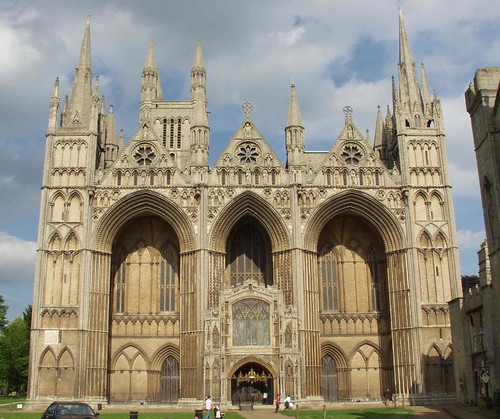
But you can’t beat the view above, across the lovely grassed square at the front of the cathedral.Its second glory is the painted ceiling pictured below, dating back to about 1230. This must have been a truly important place then – perhaps a growing wool economy? – althought the important was helped by an enthusiastic abbott, Aelfsey (abbott from 1005-1055 – he must have started young).
A chronicler described him as “a laborious bee”, and gullible is another word that might have been applied. He collected “part of Aaron’s rod, piece of Our Lord’s swaddling cloth, a shoulder blade of one of the Holy Innocents [the babies killed by Herod] and a piece of bread from the feeding of the 5,000″. Although it was his successor who got “St Oswald’s arm“, which was to be the monastery’s most important relic until the Dissolution.
A really battered memorial, perhaps fairly really, of John Chambers, the last abbott, who became the first bishop of the diocese of Peterborough (so quite happy to change sides) marks that.
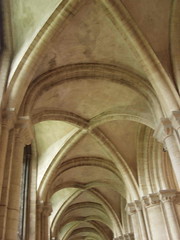 A reminder of just how early this is comes from the images of vaulting below – this technique had been invented only a few years earlier in Durham. When you look at the soaring height of that ceiling you do wonder about the scaffolding required but this didn’t necessarily start from the ground level, but from putlog holes – putlogs being horizontal wooden beams that were inserted into holes in the wall and formed a base for scaffolding or a place over which pulleys could be run to lift materials.
A reminder of just how early this is comes from the images of vaulting below – this technique had been invented only a few years earlier in Durham. When you look at the soaring height of that ceiling you do wonder about the scaffolding required but this didn’t necessarily start from the ground level, but from putlog holes – putlogs being horizontal wooden beams that were inserted into holes in the wall and formed a base for scaffolding or a place over which pulleys could be run to lift materials.
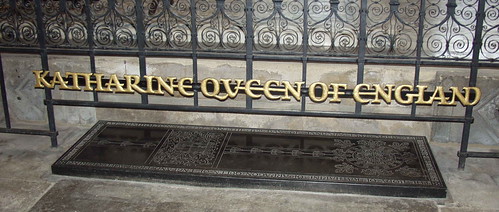
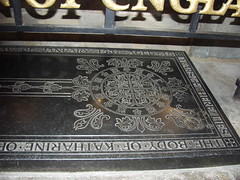 This is a cathedral in which women seem to be usually prominent, but there stories all seem to be, in one way or another, sad ones. This the humble grave of Henry VIII’s Katharine – overshadowed by the fancy memorials of mere minor gentry around it. Quite a comedown for a Princess of Spain.Just across the nave was the (temporary) burial place of Mary Queen of Scots Her body had been held at Fotheringhay Castle between her execution on 8 February 1587 and 30th July, when under the cover of night a small procession set out for the cathedral, arriving at 2am for a rapid burial, although there was a funeral service on August 7.
This is a cathedral in which women seem to be usually prominent, but there stories all seem to be, in one way or another, sad ones. This the humble grave of Henry VIII’s Katharine – overshadowed by the fancy memorials of mere minor gentry around it. Quite a comedown for a Princess of Spain.Just across the nave was the (temporary) burial place of Mary Queen of Scots Her body had been held at Fotheringhay Castle between her execution on 8 February 1587 and 30th July, when under the cover of night a small procession set out for the cathedral, arriving at 2am for a rapid burial, although there was a funeral service on August 7.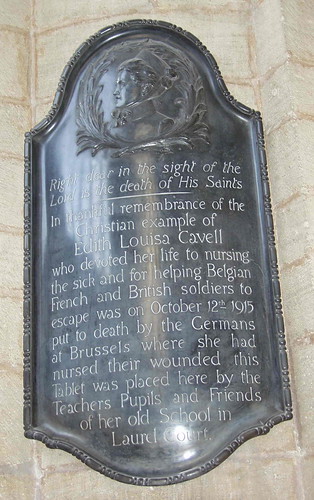 Close to the door is the memorial to Edith Cavell, the British nurse executed in 1915 by the Germans. Underneath her memorial is another, smaller, one – about the only happy women’s story I found, to Margaret Gibson, “the first honorary freewoman of Peteborough”, who had been schoolmistress at Laurel Court school, which Cavell had attended, from 1877 to 1928 – “a true wise and brave gentlewoman”.The town today is a pale shadow of past glories – has that particular feel of a place that was once somewhere and is now nowhere much – a manufacturing centre that obviously has a large immigrant population. One of employment agencies in the town had signs in its window in Polish, a cyrillic script that I assumed was Russian, and another eastern European-looking language. It’s a new age of pilgrimage.
Close to the door is the memorial to Edith Cavell, the British nurse executed in 1915 by the Germans. Underneath her memorial is another, smaller, one – about the only happy women’s story I found, to Margaret Gibson, “the first honorary freewoman of Peteborough”, who had been schoolmistress at Laurel Court school, which Cavell had attended, from 1877 to 1928 – “a true wise and brave gentlewoman”.The town today is a pale shadow of past glories – has that particular feel of a place that was once somewhere and is now nowhere much – a manufacturing centre that obviously has a large immigrant population. One of employment agencies in the town had signs in its window in Polish, a cyrillic script that I assumed was Russian, and another eastern European-looking language. It’s a new age of pilgrimage.
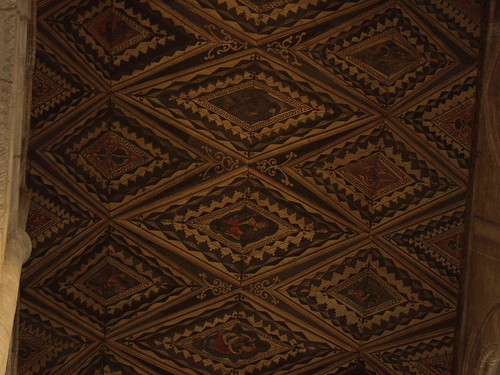

 About
About
One comment